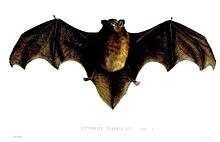New Zealand long-tailed bat
| New Zealand long-tailed bat | |
|---|---|
 | |
| Scientific classification | |
| Kingdom: | Animalia |
| Phylum: | Chordata |
| Class: | Mammalia |
| Order: | Chiroptera |
| Family: | Vespertilionidae |
| Genus: | Chalinolobus |
| Species: | C. tuberculatus |
| Binomial name | |
| Chalinolobus tuberculatus (Forster, 1844) | |
The New Zealand long-tailed bat (Chalinolobus tuberculatus), also known as the long-tailed wattled bat or pekapeka-tou-roa (Māori), is one of 15 species of bats in the genus Chalinolobus variously known as "pied bats", "wattled bats" or "long-tailed bats". It is endemic to New Zealand, but is closely related to five other species of wattled or lobe-lipped bats in Australia and elsewhere.
Description
The bat's echolocation calls include a relatively low frequency component which can be heard by some people. It can fly at 60 kilometres per hour and has a very large home range (100 km²). It weighs 8-12g. Life expectancy for this species is unknown, though it exceeds nine years.[1]
Diet
This species hunts by hawking, or capturing and consuming aerial insects while flying.[2] Flies are the most significant food source, with moths and beetles also important.[3] The bat is an insect generalist, consuming insects that are abundant in the landscape.[3]
Roosting
New Zealand long-tailed bats are selective when choosing roost trees. Preferred roost trees are located at low altitude at the bottoms of valleys, less than 500 metres (0.31 mi) from the woodland edge.[4] The bats prefer tall roosts of large diameter located in areas of lower tree density, particularly live red beech trees or snags.[4] Three-quarters of roost trees identified on the South Island were at least one hundred years old.[4] The bats roost in small cavities within the trees that have high temperatures and humidity.[5]
Reproduction
Males and females are capable of successful reproduction after their first year, and most females first give birth at age two or three.[1] Mating is thought to occur in February and March, shortly before hibernation, based on the proportion of males with swollen epididymides at this time.[1]Females give birth to a single pup during austral summer (December and January) and provide sole care for their young, gathering with other females in maternity roosts of up to 120 individuals; small numbers of adult males and nonreproductive females are present in the roosts as well.[1] These subcolonies move to new trees almost every day, breaking apart into smaller groups or reforming into larger ones. In some areas limestone caves are also used but mainly as a night roost between feeding bouts. Pups fledge about 40 days after birth.[1] Pups are likely weaned within ten days of fledging.[1]
Conservation
The species first gained legal protection under the New Zealand Wildlife Act 1953.[6] For management and conservation purposes, the long-tailed bat of New Zealand is divided into two populations: the North Island and the South Island. The South Island population is recognized in New Zealand as "Nationally Critical" due to a rapid population decline, while the North Island population is recognized as "Nationally Vulnerable" due to a moderate population decline.[7] The bats' preference for large, old roost trees makes them at-risk from habitat destruction via logging.[8]
References
- 1 2 3 4 5 6 O'Donnell, C. F. (2002). Timing of breeding, productivity and survival of long-tailed bats Chalinolobus tuberculatus (Chiroptera: Vespertilionidae) in cold-temperate rainforest in New Zealand. Journal of Zoology, 257(03), 311-323.
- ↑ Rockell, G., Littlemore, J., & Scrimgeour, J. (2017). Habitat preferences of long-tailed bats Chalinolobus tuberculatusalong forested riparian corridors in the Pikiariki Ecological Area, Pureora Forest Park.
- 1 2 Gurau, A.L. (2014). The diet of the New Zealand long-tailed bat, Chalinolobus tuberculatus. Massey University.
- 1 2 3 Sedgeley, J. A., & O'Donnell, C. F. (1999). Roost selection by the long-tailed bat, Chalinolobus tuberculatus, in temperate New Zealand rainforest and its implications for the conservation of bats in managed forests. Biological conservation, 88(2), 261-276.
- ↑ Sedgeley, J. A. (2001). Quality of cavity microclimate as a factor influencing selection of maternity roosts by a tree‐dwelling bat, Chalinolobus tuberculatus, in New Zealand. Journal of Applied Ecology, 38(2), 425-438.
- ↑ O’Donnell, C. F. (2000). Conservation status and causes of decline of the threatened New Zealand long‐tailed bat Chalinolobus tuberculatus (Chiroptera: Vespertilionidae). Mammal Review, 30(2), 89-106.
- ↑ O'Donnell, C.F.J; Christie, J.E.; Lloyd, B.; Parsons, S.; Hitchmough, R.A. (2012). "Conservation Status of New Zealand Bats" (PDF). New Zealand Department of Conservation. Retrieved April 29, 2017.
- ↑ Sedgeley, J. A. (2003). Roost site selection and roosting behaviour in lesser short‐tailed bats (Mystacina tuberculata) in comparison with long‐tailed bats (Chalinolobus tuberculatus) in Nothofagus forest, Fiordland. New Zealand Journal of Zoology, 30(3), 227-241.
External links
- NZ Department of Conservation Bat Site
- Canterbury Nature Site
- DoC 1995 distribution map on page 4
